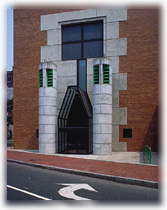![]()
Main Menu · Search · Current Issue · Contact · Archives · Centennial · Letters to the Editor · FAQs
![]()
Main Menu · Search · Current Issue · Contact · Archives · Centennial · Letters to the Editor · FAQs
 The façade of the Sackler Museum, built to receive an aerial connector from the Fogg. CHRISTOPHER S. JOHNSON The façade of the Sackler Museum, built to receive an aerial connector from the Fogg. CHRISTOPHER S. JOHNSON |
When construction of the Arthur M. Sackler Museum began in 1982, just across Broadway from the Fogg Art Museum, officials of the art museums confidently thought they would build an aerial connector spanning the street and joining the two buildings. James Stirling, the Sackler's British architect, made a design for a pedestrian gallery-bridge of generous proportions. The aspiration to construct it accounts for the existence of the square potential opening and the two stout support columns that have stood at the front of the Sackler, unemployed, since the building opened.
Neighborhood opposition and balky city permitters quashed the connector, with the inconvenient result that objects being moved from one museum to the other have to be taken outdoors. But a connection may yet be made.
The museums have just begun to develop a master plan for the future of their complex, says James Cuno, Ph.D. '85, professor of fine arts and Cabot director of the University Art Museums. "We are in the exploring phase with ourselves and our architect, to determine what our needs are and what we might do."
The project architect is Renzo Piano, of Genoa, Italy, this year's winner of architecture's highest honor, the Pritzker Prize. One of the structural possibilities that he is considering is an underground link between the Fogg and Busch-Reisinger Museums and the Sackler. (Harvard suggested this would be too costly and impractical back in the 1980s when opponents of the sky bridge proposed such a thing.) "We won't be ready until late fall or the turn of the year," says Cuno, "to begin the public process of negotiations with the neighborhood."